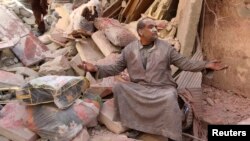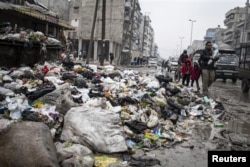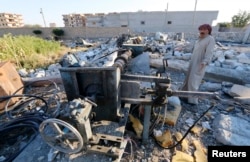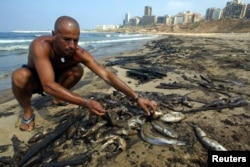War destroys people, infrastructure and economies, but activists say we still don’t have a clear idea of its long-term impact on the environment and civilian health -- much less, who should be responsible for the clean-up.
Five years into the Syrian conflict, about half of all urban areas are in ruin, says Wim Zwijnenburg, project leader for PAX, a humanitarian disarmament group based in the Netherlands. Left behind are millions of tons of “conflict rubble” – a mix of crushed cement, mangled metal, industrial and medical waste, asbestos and explosives residues that have to be removed, transported and either disposed of or stored.
“And it’s not yet clear to what extent that could be an environmental health issue,” Zwijnenburg said, “but looking for example at September 11th, when first responders were cleaning up the rubble from the World Trade Towers, years after, they face a lot of health problems because of being exposed to all the dust.”
"The debris pile acted like a chemical factory," said atmospheric scientist Thomas Cahill, who conducted a study of air quality at Ground Zero. “It cooked together the components of the buildings and their contents, including enormous numbers of computers, and gave off gases of toxic metals, acids and organics for at least six weeks."
Prior to the war, Syria had invested billions of dollars in creating four industrial zones to attract international investors. The largest, Sheikh Najjar, once housed hundreds of factories, primarily pharmaceutical, textiles and plastics.
“They have been severely damaged during the war, and the question is, what kind of toxins or hazards are being released,” said Zwijnenburg. Across Syria, cement plants, quarries, power stations, oil refineries and hospitals have been destroyed, likely releasing waste products and contaminants into the air, soil and water.
Ordnance, too, leaves a footprint that could also pose a long-term threat to health and the environment.
“Explosives contain substances like RDX, TNT and PBX,” said Zwijnenburg. “A lot of times there are residues left over after detonating, or if it didn’t fully detonate, explosives can start leaking and end up in the groundwater.”
Syrian’s environmental governance, poor enough prior to the war, has collapsed, resulting in a buildup of household, industrial and medical waste which is either burned or left to rot – either way, a health hazard.
Assessing damage
The U.N. Environmental Program (UNEP) was created in 1972 as the leading global environmental authority. It has conducted ecological studies in a number of post-conflict zones.
“But they need to be invited in by a country and they need sufficient free rein to go around taking samples and measurements,” said Douglas Weir, manager of the Toxic Remnants of War Project, a network of environmental and humanitarian NGO's pushing for greater protection of the environment in conflict.
If requested, the UNEP would send in teams with expertise in waste management, water quality, asbestos and soil/land contamination to take samples of water, soil, ash, dust and more.
The U.N. would also compare its findings with baseline data on Syria’s environment prior to the conflict, something that could be problematic.
All this is assuming that world governments contribute to the effort.
Germany, Switzerland and Norway, for example, funded UNEP's assessment in Lebanon after the 2006 war with Israel.
“Syria was an up-and-coming industrial state,” Zwijnenburg said, “but there were hardly any regulations in place, nor a sufficient, capable government able to deal with all the complexities of industrialization.”
The Syrian government, he added, also did a poor job of collecting environmental data.
Determining liability
So who will ultimately pay the price for cleaning up Syria?
“That is probably one of the least popular conversations among governments involved in armed conflicts,” said Weir. “Environmental law in peacetime has blossomed since the 1960's and 1970's, but the only place law hasn’t been developed is in relation to conflict.”
Only once has a state been forced to be liable for damage, said Weir.
“In the 1991 Gulf War, after Iraq bombed all the Kuwaiti oil wells and you had these huge fires and oil spills,” he said, the fires burned for months, sending off toxic soot, smoke and ash and causing widespread ecological damage.
The U.N. Compensation Commission evaluated millions of claims of loss and damage in Kuwait and neighboring countries and awarded more than $52 billion for damages, which were paid out from Iraq’s oil-for-food program.
Assessing culpability in Syria will be challenging, if not impossible, given the many players involved. And even in cases where liability is established, it is not easily enforced. During its 2006 war with Lebanon, Israel bombed a power station’s oil storage depot. Fifteen thousand tons of heating oil formed a 150-kilometer oil slick along the coast of Lebanon and Syria.
The U.N. General Assembly subsequently adopted nine non-binding resolutions calling on Israel to compensate Lebanon more than $850 million in cleanup costs. Israel has refused to do so, citing lost lives and environmental damage of its own and pointing out that Hezbollah started the war.
In announcing the findings of the 2006 assessment of Lebanon, UNEP director Achim Steiner noted that the international community could be of great help in providing dollars and technical support with cleanup efforts.
In the end, more than a dozen countries helped clean up Lebanon. The refugee problem , however, has strained budgets and tempers across Europe and the Middle East. It is too soon to tell how generous these economies can afford to be when it comes to mopping up and rebuilding Syria.










